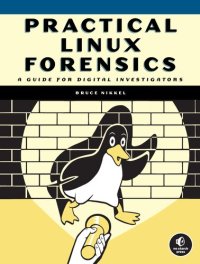
Ebook: Practical Linux Forensics: A Guide For Digital Investigators
Author: Bruce Nikkel
- Genre: Computers // Security
- Tags: Digital Forensic Science, Linux, Computer Crimes: Investigation, Data Recovery (Computer Science)
- Year: 2021
- Publisher: No Starch Press
- Edition: 1
- Language: English
- pdf
Practical Linux Forensics dives into the technical details of analyzing postmortem forensic images of Linux systems that have been misused, abused, or the target of malicious attacks. This essential practitioner’s guide will show you how to locate and interpret digital evidence found on Linux desktops, servers, and IoT devices, draw logical conclusions, and reconstruct timelines of past activity after a crime or security incident. It's a book written for investigators with varying levels of Linux experience, and the techniques shown are independent of the forensic analysis platform and tools used. Early chapters provide an overview of digital forensics as well as an introduction to the Linux operating system and popular distributions. From there, the book describes the analysis of storage, filesystems, files and directories, installed software packages, and logs. Special focus is given to examining human user activity such as logins, desktop environments and artifacts, home directories, regional settings, and peripheral devices used. You’ll learn how to:
Analyze partition tables, volume management, Linux filesystems, and directory layout
Reconstruct the Linux startup process, from system boot and kernel initialization, to systemd unit files leading up to a graphical login
Perform historical analysis of power, temperature, and physical environment, and find evidence of sleep, hibernation, shutdowns, reboots, and crashes
Analyze network configuration, including interfaces, addresses, network managers, DNS, wireless artifacts, VPNs, firewalls, and proxy settings
Perform analysis of time and locale settings, internationalization (language and keyboard settings), and Linux geolocation services
Reconstruct user login sessions, analyze desktop artifacts, and identify traces of attached peripheral devices, including disks, printers, and mobile devices
Analyze partition tables, volume management, Linux filesystems, and directory layout
Reconstruct the Linux startup process, from system boot and kernel initialization, to systemd unit files leading up to a graphical login
Perform historical analysis of power, temperature, and physical environment, and find evidence of sleep, hibernation, shutdowns, reboots, and crashes
Analyze network configuration, including interfaces, addresses, network managers, DNS, wireless artifacts, VPNs, firewalls, and proxy settings
Perform analysis of time and locale settings, internationalization (language and keyboard settings), and Linux geolocation services
Reconstruct user login sessions, analyze desktop artifacts, and identify traces of attached peripheral devices, including disks, printers, and mobile devices
Download the book Practical Linux Forensics: A Guide For Digital Investigators for free or read online
Continue reading on any device:

Last viewed books
Related books
{related-news}
Comments (0)